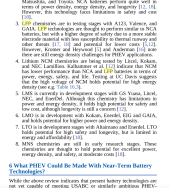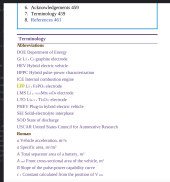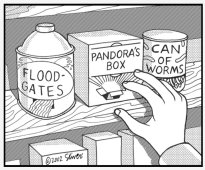I've seen a bunch of your posts on here, and I think for your specific situation it would be hard to argue that anything other than a lead chemistry would be your best option.And that's great in theory, but I've never seen any basic inverter that had a dial for cut-off voltage. That only really applies to AIO's and the like. When I buy a Giandel 1200w, where's the low voltage cutoff setting? How about a RWBL? Aims? Which wires from my EPEver SCC talk to the BMS in a battery? Where's the plug on my HQST or RichSolar that tells the battery to stop feeding the inverter?
Yes, we have to rely on the BMS to cut off power, the only other option seems to be eating the standby wattage for an AIO with communications ports that have to be configured and programmed... ya know, $RealMoney and WAY overcomplicated and oversized systems for a couple lights and a battery tender in the garden shed, which is exactly the opposite of what I expect a battery to do, which is to provide power at the terminals, charge up when the sun comes out, and discharge when I need it.
.
You are using an out of date browser. It may not display this or other websites correctly.
You should upgrade or use an alternative browser.
You should upgrade or use an alternative browser.
Are there any LiFe batteries that just "Work"? (a bit of a vent)
- Thread starter Rednecktek
- Start date
robby
Photon Vampire
- Joined
- May 1, 2021
- Messages
- 4,118
Thats a common misconception, The heaters are not connected to the batteries, they can either be connected to their own solar panel or directly to the charge controller.I'm just terrified that the heaters will completely drain the batteries and they'll be a $2000 paper weight. That's a LOT of cat food to risk, ya know?
BaronVerde
In solar orbit
- Joined
- Feb 9, 2022
- Messages
- 64
@Rednecktek , have you looked at LTO and nickel/iron (NiFe) batteries ? The former if lithium tech is a must have, the latter if you like inkaputtable ...
Just fantasizing, maybe you could compare their pros and cons with your list of requirements, and find a better match.
Just fantasizing, maybe you could compare their pros and cons with your list of requirements, and find a better match.
The New JC777
New Member
- Joined
- Sep 17, 2020
- Messages
- 152
Maybe LFP= Lithium Ferro Phosphate?LFP is the abbreviation for large format prismatic.
You can get LFP cells that aren’t LiFePO4
Sojourner1
Itinerant
I thought the abbreviation for agm and fla was just "dead lead" that way it covers all of yesterday's paperweights.What is a LiFe battery? Do you mean LiFePO4? If you wish to abbreviate LiFePO₄ then it would be LFP, not LiFe.This goes well with AGM and FLA.
DerpsyDoodler
Solar Addict
- Joined
- Jan 10, 2021
- Messages
- 2,247
LFP stores well. Much better than FLA. Drop them to 50% SoC and disconnect them. You'll easily be good for the 6-7 months you don't use them. When it's time to crank them back up, connect them and hit the charge button. I forget what the self-depletion rate is, but it is lower than lead acid and you don't have to worry about them sulfating/losing capacity. The damaging points of LFP are over-discharging (past low voltage cutoff) over-charging (past high voltage cutoff) charging in below freezing temps, and charging/discharging in temps above 90F. The temperature situation is less important if they're stored in a temperature controlled environment, which easy to do because LFP is deemed safe for habitable spaces.No, I have not yet. The cost barrier, unattended nature, and weather conditions have made me very hesitant to replace my FLA's with LFP's as of yet. My systems can't keep up through winters in the PNW as it is (200w and 300w systems are both incapable of generating 120Wh/day) and I've already had to recondition or replace multiple batteries. So far I'm just over the cost of a single Battleborn 100Ah battery between 3 systems (6x 120Ah FLA's @ $100ea, 4x 12Ah AGM's @ $50ea, and a 36Ah AGM @ $75), so I'm real hesitant to drop $RealMoney on a single LFP that, odds are, I'm going to destroy. Especially when I need so many in various places and voltages.
It just seems to me that with so many things that can go wrong, and so much hands-on time required, it's not worth the investment. I don't know if it's just that there ARE no good BMS's for my needs, or if I'm just going to have to spend a fortune in shipping every time I get home to send BB's back for warranty. The only advantages to LFP seem to be the energy density, I.E. Watts/cubic inch and that's not a factor in any of my situations.
I guess my point is, LFP's aren't perfect for everyone, I'd I'm one of those outliers.It seems like asking LFP's to be as reliable and bulletproof as FLA's is just asking too much at this level of technology.
P.S. Being a solar enthusiast in the PNW really SUCKS 4-5 months a year!
Maybe LFP= Lithium Ferro Phosphate?
Yes, many people incorrectly use LFP in that way, ignorant of the fact that LFP was used as an abbreviation for “large format prismatic” before there were any LiFePO4 cells in commercial production.
Things change, if most of the world started calling the color of the sky red then i guess that’s the color it would be? The “blue sky-ers” would all die off eventually.
DerpsyDoodler
Solar Addict
- Joined
- Jan 10, 2021
- Messages
- 2,247
Regardless, LFP is short and sweet, also commonly used on this forum to abbreviate lithium iron phosphate. Why LIP was never used is beyond me, but wtf ever. IDGAF, TBH, as long as we can all agree on it and therefore communicate with understanding. That is what's important here. If splitting hair was a sustainable way to generate or store electrical energy, I'd be all for it.Yes, many people incorrectly use LFP in that way, ignorant of the fact that LFP was used as an abbreviation for “large format prismatic” before there were any LiFePO4 cells in commercial production.
Things change, if most of the world started calling the color of the sky red then i guess that’s the color it would be? The “blue sky-ers” would all die off eventually.
The New JC777
New Member
- Joined
- Sep 17, 2020
- Messages
- 152
Thanks for the info.Yes, many people incorrectly use LFP in that way, ignorant of the fact that LFP was used as an abbreviation for “large format prismatic” before there were any LiFePO4 cells in commercial production.
Things change, if most of the world started calling the color of the sky red then i guess that’s the color it would be? The “blue sky-ers” would all die off eventually.
My guess is that because LFP is short for LiFePO₄, not the words Lithium Iron Phosphate.Why LIP was never used is beyond me
I can find no references anywhere for someone using LFP to mean large format prismatic however using LFP for lithium iron chemistry seems to go back to at least 2007 when these batteries where first being looked at for EV use in publication such as this one:Yes, many people incorrectly use LFP in that way, ignorant of the fact that LFP was used as an abbreviation for “large format prismatic” before there were any LiFePO4 cells in commercial production.
Things change, if most of the world started calling the color of the sky red then i guess that’s the color it would be? The “blue sky-ers” would all die off eventually.
https://www.google.com/books/edition/Industrial_Applications_of_Batteries/WDeNFaDC-LcC?hl=en&gbpv=0


Regardless, LFP is short and sweet, also commonly used on this forum to abbreviate lithium iron phosphate. Why LIP was never used is beyond me, but wtf ever. IDGAF, TBH, as long as we can all agree on it and therefore communicate with understanding. That is what's important here. If splitting hair was a sustainable way to generate or store electrical energy, I'd be all for it.
It may well be splitting hairs, but if i start using the acronym FLA (Ferrous Lithium Assembly) for LiFePO4, and a heap of people start copying that - it would be confusing. That’s exactly what happened when ignorant people confused large format prismatic with LiFePO4.
Personally i couldn’t care less, i just thought it was amusing that someone came along saying it was wrong to abbreviate LiFePO4 to “LiFe”, then incorrectly said it should be abbreviated to LFP.
Curious as to what everyone thinks the abbreviation for “large format prismatic” actually is if it’s not LFP.
It’s fine on a beginner forum like this, but when you are dealing with cylindrical, pouch and large format prismatic cells that aren’t always LiFePO4, it’s important to use abbreviations correctly.
Large format prismatic is not used enough to warrant abbreviating it and would be confusing since LFP has been used to denote chemistry in publications for many years.Curious as to what everyone thinks the abbreviation for “large format prismatic” actually is if it’s not LFP.
I can find no references anywhere for someone using LFP to mean large format prismatic however using LFP for lithium iron chemistry seems to go back to at least 2007 when these batteries where first being looked at for EV use in publication such as this one:
https://www.google.com/books/edition/Industrial_Applications_of_Batteries/WDeNFaDC-LcC?hl=en&gbpv=0
View attachment 86131View attachment 86132
Yes, the incorrect use of LFP for LiFePO4 began around 2007 when commercial LiFePO4 became available.
Before then, LFP was used as an abbreviation for large format prismatic cells.
I guess it’s a history lesson now.
DerpsyDoodler
Solar Addict
- Joined
- Jan 10, 2021
- Messages
- 2,247
I can find no references anywhere for someone using LFP to mean large format prismatic however using LFP for lithium iron chemistry seems to go back to at least 2007 when these batteries where first being looked at for EV use in publication such as this one:
https://www.google.com/books/edition/Industrial_Applications_of_Batteries/WDeNFaDC-LcC?hl=en&gbpv=
IDGAF how right anyone else may or may not be, the first person to use a credible reference wins.
You, sir, are king of the internet for a day.
?
Are you sure it wasn’t used for large format pouch cells, why do the prismatics get the abbreviation?Before then, LFP was used as an abbreviation for large format prismatic cells.
Rednecktek
Solar Wizard
Lol! The 2 most common situations where I'd need to run my batteries.charging in below freezing temps, and charging/discharging in temps above 90F.
Unfortunately none of my use cases are temperature controlled environments. About the best I can do is keep the rain off.The temperature situation is less important if they're stored in a temperature controlled environment, which easy to do because LFP is deemed safe for habitable spaces.
12VoltInstalls
life passes by too quickly to not live in freedom
I don’t really see my lead acid system- albeit only 8 batteries at 12V- as having more “gotchas” than LiFePo.LiFePO4 have far, far less gottchas and problems than Lead Acid. We are just all programmed to know how to deal with lead acid so we expect and deal with those issues without much thought about it. LFP has only a couple very easy to deal with issues, and we get confused because they go against our programming.
I started with two eight year old FLA marine batteries just because I had them but little cash at the time. They ran a year. THAT was inexpensive.
I bought two then four walmartha marine batteries. I have eight now. After several years use still meeting needs, and now that winter is waning they are happier (they make the coffeemaker run better at 35*F than -10*F)
That’s ~400Ah of usable for under $800 and they just keep working.
In my case with the batteries living outside in Vermont… lead is better for the present use.LFP is a godsend in the simplicity of how well it works.
LFP has to be above 32. If my land quest comes to fruition this summer, however, a secondary system to keep the furnace fan happy using LFP makes sense. That’s the constant draw overhead this winter that exceeded the sun or FLA abilities, and you can recharge lithium at a ridiculously fast rate if needed.
It’s not versus the other to me. It’s what makes sense in a circumstance. Plus for critical use I still have more faith in lead acid batteries than LiFePo. No bms failure, no charging concern- just add water maybe occasionally.
Lithium is good, not saying it’s not better in a lot of circumstances, not saying it can be cheaper longterm. But lead is probably going to have a place in solar for a long time to come.
DerpsyDoodler
Solar Addict
- Joined
- Jan 10, 2021
- Messages
- 2,247
...But lead is probably going to have a place in solar for a long time to come.
It will become niche as LFP becomes more and more mainstream and the gotchas of it become more reliably solved. That's my prediction, anyway.
Similar threads
- Replies
- 18
- Views
- 525
- Replies
- 10
- Views
- 333
- Replies
- 27
- Views
- 947



